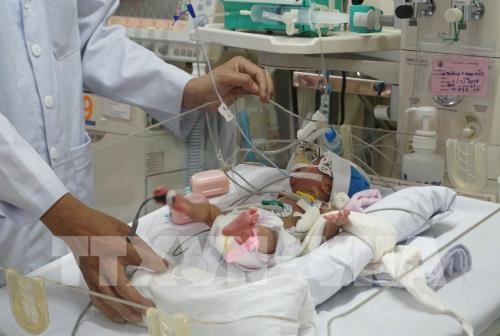 Society
Society

In the neonatal intensive care unit at HCM City’s Pediatrics Hospital 1, overcrowding can become so severe that some infants must stay in beds in the corridors.
 |
| A prematurely born infant is treated at HCM City Pediatrics Hospital 1. —VNA/VNS Photo Phương Vy |
HCM CITY— In the neonatal intensive care unit at HCM City’s Pediatrics Hospital 1, overcrowding can become so severe that some infants must stay in beds in the corridors.
Despite fans, the hospital rooms are hot and stuffy. Two or three infants often share a bed while their respective relatives wait under the stairs, taking turns to care for the children.
For infants treated at the unit’s emergency room, their parents or grandparents must look for an empty area to sleep on a mat overnight.
There, they wait for the doctor’s questions about the mother’s health or requests to feed their infants in the emergency room.
Nguyễn Thị Thu Thủy (not her real name) of Củ Chi District told Việt Nam News that her niece was born prematurely at a hospital in the district and transferred to the unit for further treatment.
Because the niece was being treated at the emergency room, Thủy and her child’s grandmother slept on a mat on the ground floor of the building where the emergency room is located.
Thee neonatal unit was designed to have 165 beds, but the number has reached 210, according to Tuổi trẻ (Youth) newspaper.
However, the number of hospitalised infants often reaches 250 and even 300 in the peak season.
Dr. Ngô Ngọc Quang Minh, deputy director of Pediatrics Hospital 1, said that in the past most prematurely born babies often died, but now most of them survive because of technical advances.
However, many of them are left with disabilities, infections, chronic lung disease or retinopathy of prematurity (ROP), Minh said.
The hospital admits nearly 3,000 babies with retinopathy of prematurity every year.
Most of them are transferred from other obstetrics and pediatrics hospitals in the city, as well as from provinces with medical facilities that lack sufficient equipment and staff for screening, diagnosis and treatment.
The Health Department has asked the city’s two obstretrics hospitals to improve their neonatal intensive care units so they do not have to transfer babies to the two pediatrics hospitals.
To ease the burden on Pediatrics Hospital 1, Từ Dũ Obstetrics Hospital administers tests and prepares procedures for babies with retinopathy of prematurity who are transferred to the pediatrics hospital for laser treatment or cryotherapy.
If the pediatrics hospital has no free beds, the patients, after treatment, will be transferred back to Từ Dũ Hospital for postoperative care.
In a number of cases, Từ Dũ Hospital doctors invite doctors at Pediatrics Hospital 1 and Eye Hospital to come directly to Từ Dũ to perform eye surgery on patients with retinopathy of prematurity.
Despite its assistance to other hospitals, Từ Dũ Hospital’s neonatal department is also experiencing the same problems as the unit at Pediatrics Hospital 1.
In the first nine months of the year, Từ Dũ’s neonatal department admitted 7,443 infants. It has a bed capacity of only 192.
A representative of the hospital said that that Từ Dũ must always be prepared to provide vital care to infants because 20 per cent of babies admitted to the unit have respiratory failure.
Babies with jaundice stay near their mother and are not brought to the neonatal department.
Minh said that babies who are fed breast milk could recover more quickly. If the hospitals have breast milk banks, the patients’ stay could be shortened.
Dr Bùi Thị Thủy Tiên, head of the neonatal department at Hùng Vương Obstetrics Hospital, said that infants weighing 1.8 to 2 kilogrammes are taken to the hospital’s postnatal department for “kangaroo care”, which involves infants being carried, usually by the mother, with skin-to-skin contact.
Babies with jaundice are allowed to stay with their mother in the same room in the postnatal department for light therapy, Tiên said.
These methods have helped to reduce overcrowding. In the first six months of the year, 1,438 babies were admitted, or 95 per cent of the hospital’s bed capacity.
To relieve overloading at city hospitals, Minh said that doctors in provinces should receive training via telemedicine.
Tăng Chí Thượng, deputy head of the Department of Health, has asked city-level obstetrics and pediatrics hospitals to offer more training to improve the capacity of doctors at district-level and private obstetrics hospitals in the city.
To help reduce the number of patient transfers to HCM City, he said that neonatal departments should be set up at hospitals in provinces.—VNS




